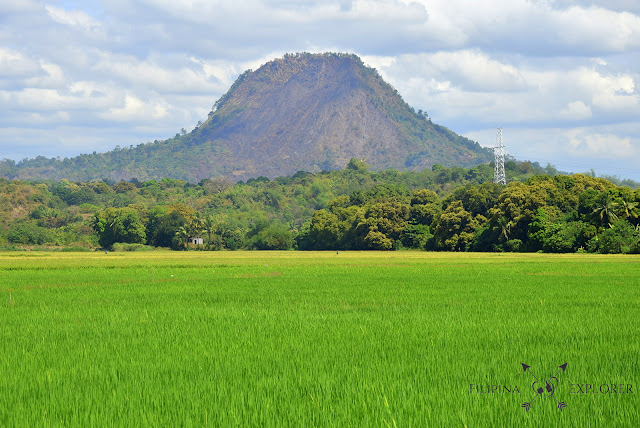In 2014, on our way to Magalawa Island in Zambales, 22-month old Lia and I saw a conical mountain along SCTEX. I wasn’t actively hiking that time yet, but I remembered being smitten by it and telling her, “Someday, we’ll go there”.
In the early days of March this year, we did.
Though Mt. Malasimbu is a famous Holy Week destination for pilgrims, it is often overshadowed by popular hiking favorites in Bataan like Tarak Ridge, Mt. Natib, and Mt. Samat. As one of the least known mountains in the province, detailed and accurate directions to Mt. Malasimbu are a rarity, and one must navigate her way to the jumpoff point without much help, even from puzzled locals. (Don’t fret. I’ve got detailed directions at the end of this post.)
The eight-kilometer hike up the 411-meter high peak starts at Brgy. Barangay Bayan-Bayanan and passes through a local community of Aetas for about a kilometer or two. En route, there are streams that serve the community’s bathing and laundry needs.
After that, the trail consists of alternating forests and open grasslands that are reminiscent of Mt. Arayat and Tanay mountains, respectively. One of the first notable forested sections is a patch of land that houses mahogany trees (Swietenia species). According to our guide, this was an initiative spearheaded by the owner of that parcel of land who is a Forestry graduate.
Decades ago, in an effort to “solve reforestation”, the DENR ordered that millions of mahogany seedlings from the Americas be planted in the country.
It’s saddening that this is still the thinking today, because the truth is, mahogany creates more problems than good. It is lethal to biodiversity. It’s not native to the Philippines, and it proves to be pestilent, quickly replacing other native timbers when planted. Mahogany does not bear fruits, so you won’t see birds seeking food or shade under it. Insects and beneficial fungi do not thrive where mahogany does, making that zone useless.
 |
| Pretty but deadly. Mahogany trees, that is. |
I’m sure everyone who plants trees have the best intentions, but not everyone is aware of the repercussions of planting foreign trees in the Philippines.
But I digress.
Onward to the summit, you will be negotiating some steep sections with loose soil, as well as gently ascending open grasslands that are similar to many open mountains in Rizal like Mt. Maynabu, Tangwa Peak, and Mt. Binutasan. Except in Holy Week when locals cut grass to ease the hike for pilgrims, overgrowth in these sections is terribly thick and long. So much so that in some parts, you won’t see the person in front or where the trail leads.
The overgrowth can easily derail climbers, which is a nightmare because the sun in this part of Bataan tends to be so intense it drains you within minutes. I am not exaggerating. There are three short sections like this – each around five to 10 minutes each – so it’s best to hike in the morning. Wear arm and leg protection while doing so.
 |
| At times, we can not see our guide due to the sheer thickness and height of grass along the trail. |
The second grassland will afford you a view of nearby mountains, most prominently Mt. Samat-Samatan, which can also be accessed by the same route. According to our guide, while the summit of the mountain is higher than Mt. Malasimbu, it’s easier to trek, taking only a maximum of two hours (with a shortcut trail) on slow pacing.
 |
| Mt. Samat-Samatan as viewed from one of the grasslands in Mt. Malasimbu |
We were told that there is a stream near the summit, and on it, a cross. The peak overlooks the plains of Bataan and Pampanga. We didn’t see this, however.
The searing heat amid thick and tall cogon grass proved to be too daunting for Lia that at 2:30 pm, we still had three kilometers to endure (plus five more on the way back). She had gulped down nearly two liters of our water. We had none left for the duration of the trail. We had to turn back, lest we want to get dehydrated.
On our way down, we swam in one of the streams with some Aeta kids. Afterwards, locals invited us to their home to eat birthday pancit while Lia played with their kids. Somebody gave me unused granny panties because I forgot to bring extra. The locals of Bayan-Bayanan are a true testament of trademark Filipino hospitality. It’s a refreshing experience to be reminded that the mountains are a place to relearn that.
At dinner, I asked Lia what she liked best about our hike. Her eyes beamed. “Lahat! Happy ako sa lahat.” (Everything! I am happy with everything”) I guess she was. Not once did she ask for cellphone. We didn’t fight the entire day either. We were happy.
For most people, a successful hike is reaching the summit. For me though, a great hike is one that shows us wonders we don’t often see or hear. It’s one that takes us back to the primal joys of nature and makes us feel more alive. A successful hike is something that changes you, however small.
Our hike to Mt. Malasimbu wasn’t just a great hike. It was a success. In fact, thinking now about the years we waited to explore it, it’s a dream come true.
TRAVEL NOTES:
Best time to hike:
An early morning hike (around 4 to 5 am) is recommended to avoid the skin-braising heat of the sun. Bring flashlight.
How to get there and back via public transportation:
Board a bus from Manila or SM San Fernando (Pampanga) going to Olongapo. Take the one that goes to Dinalupihan, not the one that passes through SCTEX. There are various buses serving this route, including Saulog Transit, Arayat Express, Genesis, Bataan Transit, and Victory Liner. Fare is P200+ (P75 if you are taking the bus from SM San Fernando). Travel time from Cubao is around 2 to 3 hours. Tell the driver to drop you off at Brgy. Pita in Dinalupihan. This is before Chowking. You will see a sign at the left that says “Gen. Luna”.
From there, take a tricycle going to the Brgy. Bayan-Bayanan barangay hall. Fare is P60. At the barangay hall, register and hire a guide. Guideship fee is not established yet, but P300 should be sufficient, since the hike normally takes only two to three hours (normal pace).
The first leg of the hike is mostly on concrete road. If you are lucky, tricycles are available in front of the barangay hall. You may ask one to take you to the tail end of the road, which is more or less at the store near the bigger stream. This can cut the hiking time by 30 to 45 minutes (even an hour if you are doing it really slow). Shouldn’t cost you more than P100 for a tricycle that can fit 3 to 4 people.
Tell the guide that you are taking the easier trail. If you fancy a more challenging hike, there’s another way to the summit which takes around 4 to 5 hours to complete and involves some scrambling on a cliffside. Not for those who have fear of heights, I reckon.
Going back to Manila:
You can hire a tricycle from the lot across the barangay hall going to either Plaza (P60) or Layac Junction (P80). I recommend going straight to Layac Junction since more Manila-bound buses (from Olongapo) pass by there.
Important note: A few posts I read said you should get off at San Benito/ Pag-asa. Don’t. We took this route and had to pay P120 for a tricycle going to Bayan-Bayanan. There are no guides at Pag-asa, and they will also direct you to Bayan-Bayanan, since the trail from Maligaya (what they call the “long-cut” trail from Pag-asa) takes a lot longer.
Water source:
None
What to bring:
Best to bring around 3 liters of water and a hat or an umbrella. There are open sections, which can get scorching hot. Parts of the trail also consists of loose soil, so shoes with good traction will come in handy.














